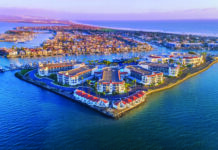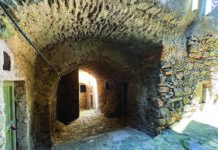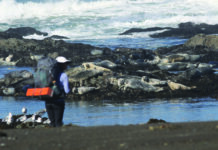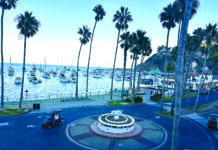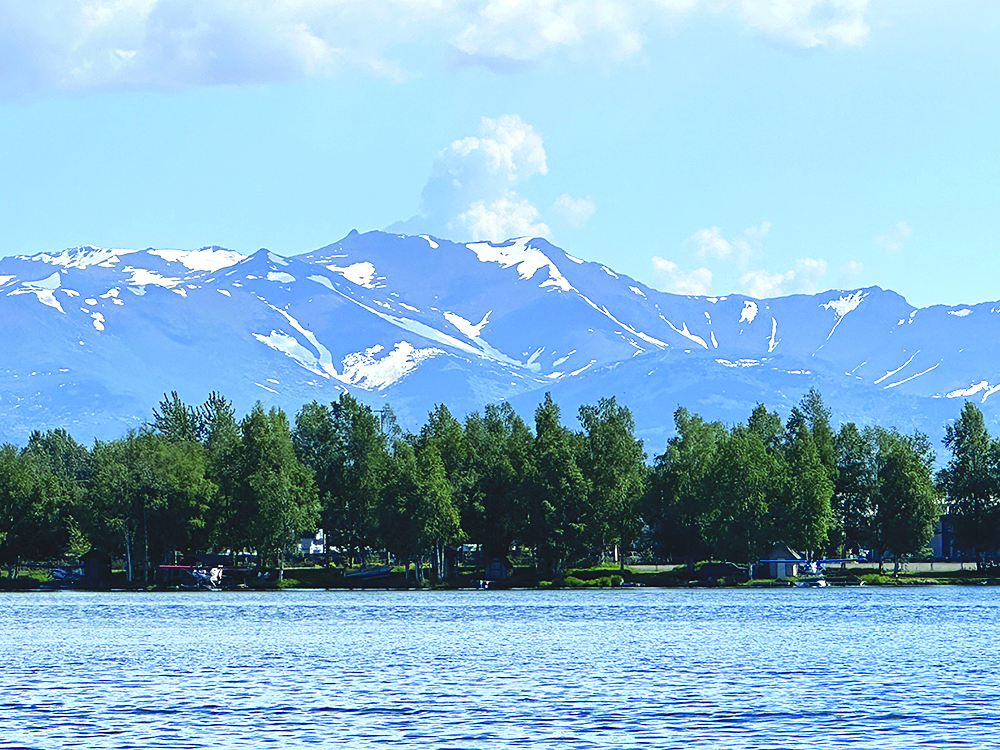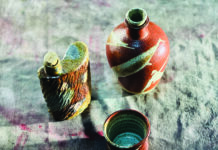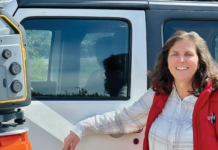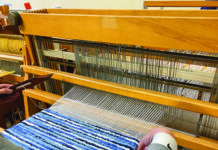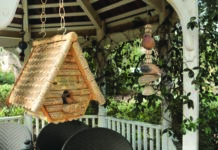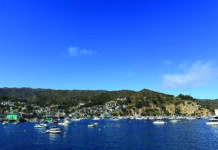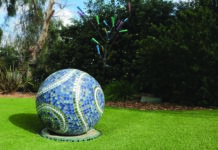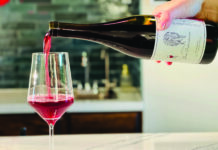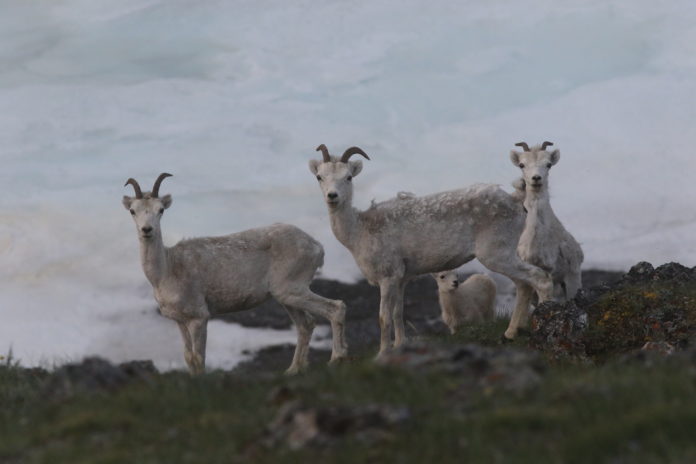The untouched wilderness of the Arctic National Wildlife Refuge.
Story and photos by Chuck Graham
From my limestone perch, doing my best to meld into a lichen-covered cathedral, I watched 18 Dall sheep gradually grazing across layers of permafrost, peat moss and hillocks, nimbly traversing above a swift-moving Kongakut River 300 feet below. This was the Arctic National Wildlife Refuge (ANWR), and the tundra biome I viewed from about 100 feet away was teeming with Alaskan wildlife.
Narrow channels called runnels braid and flow beneath the Mordor-like North Slope of the Brooks Range, rushing northward toward the Coastal Plain, gritty barrier islands, Beaufort Sea, and the Arctic Ocean. In all, the ANWR encompasses 19.3 million acres, one of the most wild, untouched habitats left on the planet.
There are no roads, no maintained trails or helipads, and the water is so sweet and clean, filtering it is always an afterthought. The only access into the ANWR is by either backpacking or flying in by bush plane and then rafting rivers like the Canning and the Kongakut. The impressive Brooks Range towers over 9,000 feet above with countless tributaries like the Pagilak and Paulaluk feeding major rivers that eventually converge with the Arctic Ocean.
Keeping the Wild in the Wilderness
Since the area became a National Wildlife Refuge in 1960, it has grown to be the largest refuge in North America. Even so, this vast area has been in the crosshairs for oil drilling. The 1.5 million acres that make up the Coastal Plain, in particular, are estimated to contain up to 11 billion barrels of oil deep beneath the permafrost. Politicians on the left and right have drawn lines in the tundra, and thus the plain was not protected.
However, this region of Northeast Alaska belongs to Alaskan Natives — the Iñupiat in the north and the Gwich’in in the southeast. They still subsist on their lands in the Arctic, relying on the 150,000-plus Porcupine caribou herd that migrates in from Northwest Canada before reaching the Coastal Plain and their calving grounds. This massive caribou herd performs the longest migration of any terrestrial mammal on the planet.
The ANWR supports 43 mammal species such as musk ox, grizzly bear, Arctic and red fox, Dall sheep, gray wolf and wolverine. During the Arctic’s brutally frigid winters, the Coastal Plain is an important denning habitat for polar bears. At least 250 bird species have been documented in the refuge. Bald and golden eagles rule the skies. Waterfowl like harlequin and long-tailed ducks, gadwall and mergansers effortlessly swim the rushing rivers. In the spring and summer, thousands of shorebirds rely on the Coastal Plain for nesting habitat, such as Dunlin, red-necked-phalaropes and semipalmated plovers, to name just a few.
If oil drilling was ever to be allowed in the ANWR, it would disrupt its natural wonders, thus setting a precedent for all remaining wild places throughout the west.
Under the Trump Administration, a provision in the 2017 federal tax bill made oil and gas exploration in ANWR the law. Leases went up for bid on January 6, 2020. Those bids fell far short of their financial mark of $900 million. About half the region received no offers at all, and not one major oil company submitted a bid. Only two smaller companies — Regenerate Alaska, a subsidiary of Australia-based 88 Energy, and Knik Arm Services, a small Alaska company owned by Mark Graber — secured leases, totaling $14 million. Many Alaskan politicians argue drilling would be good for jobs, the economy and state revenue.
However, on his very first day in office, President-elect Joe Biden put a temporary halt to oil and gas drilling in the roadless expanse of the refuge. Regenerate Alaska and Knik Arm Services have rolled back their efforts to move forward with oil exploration. The costs of building roads, helipads and other infrastructure on the Coastal Plain has apparently far outweighed the means. For now, the Arctic National Wildlife Refuge is safe.
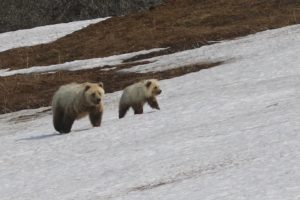
North Slope Megafauna
With only about 50 yards of spongy tundra and permafrost separating us, a wary female grizzly bear with a single cub in tow had a decision to make.
She had strategically maneuvered her way downwind of me. Just east of the Kongakut River, with the Coastal Plain 10 miles north of me, I could see her wet snout glistening in the morning sun as she sniffed the crisp Arctic air in my direction.
When I realized what she was up to, I dropped my camera pack, pulled out my bear spray, threw my pack back on, and braced myself for what might transpire. At that point, the ball was in mama bear’s court.
I wasn’t hoping for an encounter like this in Northeast Alaska. However, by rafting the Kongakut and hiking in North America’s largest wildlife refuge, I had immersed myself in this Arctic biome, and crossing paths with its wildlife was inevitable.
Seeking the wild in the wilderness has always been a priority for me. When friend and guide Carl Donohue from Expeditions Alaska messaged me about an opening on his rafting trip on the Kongakut, I didn’t hesitate.
Late June meant Summer Solstices hovered over the Arctic Circle, involving long sunny days that gratefully bedeviled me through sleepless nights. Sunset was 12:30 a.m. and sunrise was 3 a.m. It never got dark, as long mountainous shadows crept across chilly Class III and IV rapids on the Kongakut. Apparently, the mosquitoes don’t sleep, either. Donohue told me the biomass of these pest insects far outweighed the entire biomass of the Porcupine caribou herd!
Each day, as soon as I was out of the raft and had finished pitching my tent, I was trekking up colossal tributaries feeding the mighty Kongakut, binoculars and 300mm lens seemingly extensions of my body. I ditched my trail shoes and hiked barefoot most of the time. The tundra was soggy and squishy as I trekked up toward snow-capped peaks and thrashed through dense willow thickets. Amazingly, my feet never looked so clean. Encounters with Dall sheep, musk ox, Arctic ground squirrel and small herds of caribou never let me rest. And then there was that female grizzly with her precocious, blonde cub.

Room to Ramble
Once my days-worth of stench confirmed her worst fears, that girthy female grizzly did an about face and rambled eastward up the sweeping river valley, her cub doing its best to keep up. I didn’t take her decision lightly though. As I quickly hiked back to the Kongakut, every 20 paces I looked over my shoulder just to make sure she wasn’t having second thoughts. Before I knew it, they were at least a mile east of me, melding into the Arctic landscape.
As I drew closer to the Kongakut’s steady flow, the roar of the river calmed my fears. The Beaufort Sea beckoned along the Coastal Plain, and our scheduled bush plane pickup was due two days later. There was no time to waste. I was already scanning for my next moment with ANWR’s magnificent megafauna.


